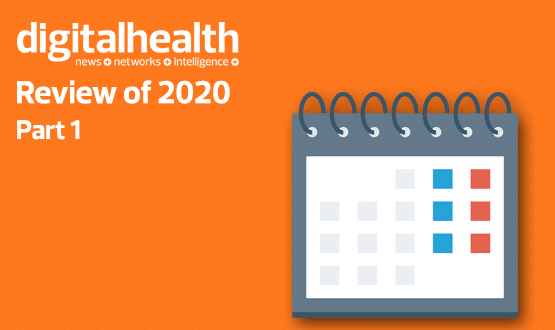Digital Health’s Review of 2020 Part One: January to June
- 29 December 2020

It’s safe to say that 2020 has been a year like no other with use of technology in the NHS making national headlines on a number of occasions. In particular, the NHS Covid-19 contact-tracing app and privacy around data storage.
But it wasn’t all Covid-19 related, there were also some big strides in other areas. The first wave of Digital Aspirant trusts were announced early on in the year and artificial intelligence continued to make headlines with further funding and research announced.
Join us as we take a look at some of the biggest stories on Digital Health in 2020, starting with January to June.

January started off with a bang, as health secretary Matt Hancock announced £40million for new technology to speed up the time it takes NHS staff to log into computer systems.
The aim of the investment was to save thousands of hours in staff login times every day, with some staff required to log into as many as 15 different systems on each shift. It was also expected to ease administrative burdens and free up time for one-to-one care.
Over the pond in the US some epic news was brewing. Account representatives from US tech firm Epic had reportedly told customers they would no longer be working with Google Cloud because it wasn’t seeing sufficient interest among its health systems customers. Instead the company would be focusing its energies on Amazon Web Services and Microsoft Azure.
The start of 2020 also saw digital healthcare company Babylon continue to grow as The Royal Wolverhampton NHS Trust signed a 10-year partnership to develop a new model of digital-first integrated care.
Patients and staff at the trust were to use Babylon’s technology to manage care through a free app connecting primary, secondary and community care.

In a bid to achieve full use of digital technology in the NHS by 2024, planning guidance revealed NHSX was exploring the idea of setting a minimum technology spend for organisations. The documents added that systems and providers “will want to ensure an appropriate level of investment in tech to achieve full use of modern digitised technology”.
Sticking with NHSX’s claims that it will set out “what good looks like” for health IT, the guidance also stated the organisation would set out its approach for mandating technology, security and data standards in early 2020/21.
February also brought more NHSX related news when Natasha Phillips was named the first chief nursing information officer (CNIO). Phillips was previously CNIO at University College London Hospitals NHS Foundation Trust and was named Digital Health’s CNIO of the Year in 2019.
Social care also made headlines this month when NHS Digital announced sixteen organisations were set to receive a share of £4.5m as part of a Social Care Digital Pathfinders grant. The funding aimed to help digital social care projects that had been piloted in small local areas to be implemented on a larger scale.

March was the month in which coronavirus began to dominate headlines. At the very beginning of the month, GP practices across the country were urged to assess patients online or via telephone and video appointments to mitigate the spread of the virus.
NHS England’s preemptive move meant millions of patients who would normally attend Britain’s 7,000 GP surgeries were triaged online, via telephone or video and contacted via text messaging services – many for the first time.
In a further bid to keep patients who should be self-isolating out of GP surgeries, sick notes were automated through NHS 111. Chancellor Rishi Sunak announced a raft of measures in this year’s budget to support the NHS during the spread of Covid-19, with part of the £30 billion package being digitally issued sick notes for patients who were self-isolating.
As Covid-19 began to spread more rapidly the need for digital solutions became more apparent. NHSX had already announced it was working on a contact-tracing app while Kings College London launched a symptom checking app so the progression of coronavirus could be tracked in real-time.

More digital tools to support the county’s response to Covid-19 were rolled out in April, including an online tool from Oxford University for tracking and comparing the policy of governments tackling the pandemic.
It was hoped the Oxford Covid-19 Government Response Tracker would help researchers understand whether increasingly strict measures affect the rate of infection.
As infection rates climbed dramatically it became clear the NHS would need additional bed capacity to cope. The government set up a number of temporary Nightingale Hospitals to increase capacity, with the site at Harrogate Convention Centre using Silverlink Software’s patient administration system (PAS) to admit patients and track them across beds and wards.
Patients with underlying conditions who were at greater risk of Covid-19 were advised to shield for 12 weeks, but in a concerning turn of events primary care clinicians were asked to flag vulnerable patients as central NHS datasets were “not sophisticated enough” to identify all groups.
The letter, seen by Digital Health News, acknowledged that databases held by NHS England were not extensive enough to identify every at-risk patient. It was one of many stories in 2020 that highlighted the need for better patient data.

The first week of May arrived, and with it the launch of the first trial of the NHS Covid-19 contact-tracing app on the Isle of Wight. The app used Bluetooth to track time and distance between users devices, which would then be used to determine if they had been exposed to the virus and needed to self-isolate.
One of the biggest concerns with the contact-tracing app was privacy. Many experts and campaigners expressed trepidation over NHSX’s decision to differ from Apple and Google’s approach to contact-tracing. The tech giants had announced earlier in the year that they were to partner to provide contact-tracing technology based on a decentralised system, meaning data would only ever be stored on devices.
But NHSX originally opted for a centralised approach, meaning data would be collected by the centre, which sparked concerns about privacy on a global scale.
In more app news – there’s a common theme here – Baroness Dido Harding was appointed to lead the programme of testing and tracing as part of the government’s ongoing response to coronavirus, which included the app.
The contact-tracing app dominated headlines for most of 2020, so if you want a full rundown of the highs and lows it faced you can read our timeline piece here.

Not too soon after the first trial of the contact-tracing app was launched – despite the privacy concerns mentioned above – NHSX announced it would abandon its model in favour of Apple and Google’s techhnology.
The organisation had previously defended it’s decision to opt for a centralised approach, stating it would provide a better view of how the virus was moving. But after field tests revealed it wasn’t up to scratch, the government began working with the tech giants to develop a new version of the app to support the “end-to-end” NHS Test and Trace service.
Privacy was still of paramount concern to people, evidenced by the popularity among readers of a story about a new Covid-19 tracking feature appearing on smartphones. The feature, which appeared on Androids and iPhones, was not a contact-tracing app but instead new settings as part of an update to operating systems, which will enable an app to run in the background.
Differing from our usual most read stories on Digital Health News, this piece proved our most popular of the month.
But June wasn’t all Covid-19 relate either (sighs of relief could be heard all round), it was also the month Northern Ireland signed a massive £275million deal with Epic to supply electronic patient records across the whole country.
The 10-year deals saw the country become one of the first parts of the UK to get fully integrated electronic health and social care record systems, replacing a patchwork of ageing legacy systems.
Part Two of our Review of 2020 will be published tomorrow (December 30)




